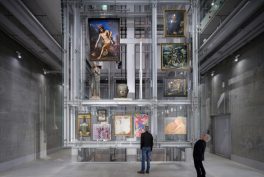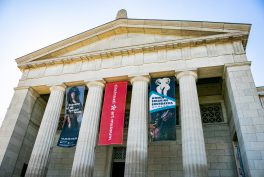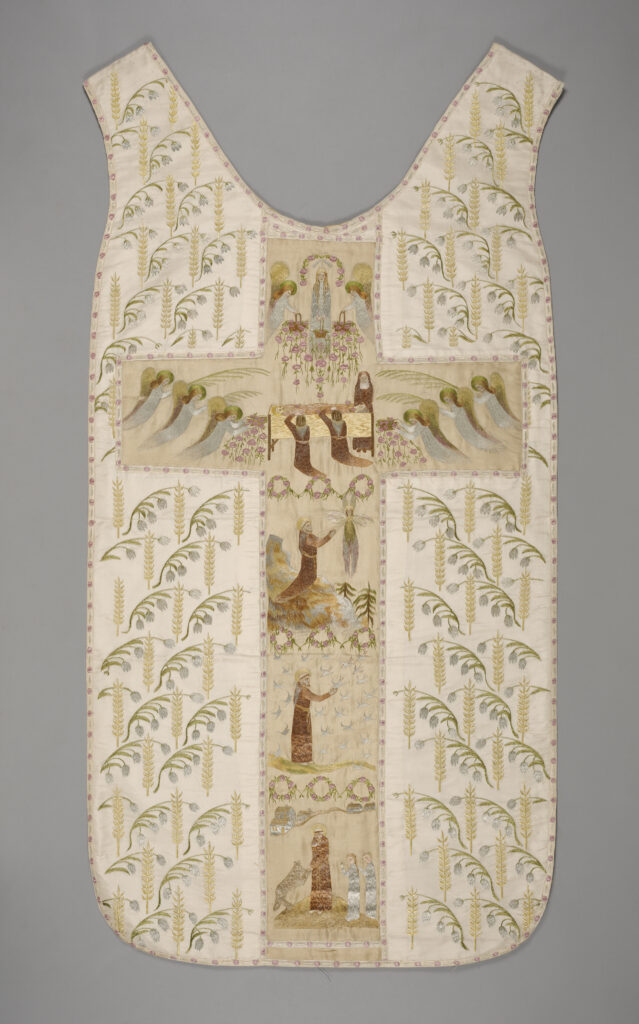1. Portrait of Feliks Jasieński in a Blue Caftan by Leon Wyczółkowski
Katarzyna Maziarz-Górka, Learning Department
Everything in this work speaks Japan—the greatest passion of Feliks “Manggha” Jasieński (1863–1929). Jasieński was one of the most popular Polish collectors and art critics and—as you can see—was somewhat of a celebrity. He loved being portrayed by his artist friends, including Leon Wyczółkowski. Interestingly enough, he had never been to Japan, though he visited a lot of countries during his numerous trips around Western Europe and Asia.
Jasieński’s collection of more than 15,000 objects included Polish Modernist paintings, prints of European artists, a set of arts and crafts artifacts, and last but not least: pieces of East Asian art, like ukiyo-e woodblock prints. In this painting, he’s holding one of the most precious ones—Clear Weather after Snow at Kameyama by Utagawa Hiroshige (from the series The Fifty-three Stations of the Tōkaidō, ca. 1833–1834).
Take a closer look at the blue Chinese caftan (from Jasieński’s collection, of course), woven in a colorful pattern with a motif of waves, dragons playing with burning pearls, and various symbols of a happy long life. It is my favorite phone wallpaper.
2. Vision by Odilon Redon
Beata Pacana, Curator at Prints and Drawings Room
This extraordinary print is the work of prominent French symbolist painter Odilon Redon (1840–1916). It comes from his first album of lithographs entitled Dans le rêve (In the Dream) published in 1879 in a run of 25 copies.
The composition shows a giant radiating eyeball concentrically spreading light and floating in an undefined space. We can tell its supernatural size by comparing it with the pair of figures in the foreground. The scene takes place in an ascetic interior with monumental columns leading into the darkness. At the same time, the columns mark the boundary between the real world and the self as defined in the artist’s original style.
The eye facing the sky sees more, it’s the gateway to the world of untamed imagination.
3. Embroidered Chasuble with Scenes from the Life of Saint Francis by Maria née Młodzianowska Szymonowicz
Joanna Kowalska, Curator, Department of Arts and Crafts, Material Culture, and Militaria
These scenes from the life of Saint Francis—who loved nature—are full of sweetness. They always put me in a good mood, especially the flock of birds listening to the saint’s words and the wolf lounging at his feet. Even such dramatic scenes as receiving the stigmata and Saint Francis’ death are portrayed in a serene atmosphere. Saint Clare and two brother monks watch by the dying man’s bed, and angels bring him handbags of fragrant roses.
The simplified form of these representations corresponds to the poverty of the lives of the Franciscan saints, while the background is ornamented with humble lilies of the valley and ears of grain. The chasuble was created for an embroidery competition organized by the Musée Industriel in Paris.
4. Temptation of Saint Anthony II by Stanisław Ignacy Witkiewicz
Dagmara Marcinek, Marketing Department Manager
Witkacy’s (Stanisław Witkiewicz’s pen name) Temptation of Saint Anthony II captivates the viewer with its intense color palette, madness, and dynamism. The artist uses grotesque, deformed shapes, presenting his take on the religious motif, repeated so often in art. Witkacy’s vision draws me in, awakens my imagination, and does not let me take my eyes off the temptations surrounding the protagonist.
This work is intriguing and doesn’t let one pass by uninterested. This is why it often appears in my museum work—used in projects promoting XX+XXI. Polish Art Gallery at the National Museum in Kraków.
5. Portrait of Wife with Pegasus in the Background by Józef Mehoffer
Beata Studziżba-Kubalska, Curator at Mehoffer Gallery
In Józef Mehoffer’s Portrait of Wife with Pegasus in the Background, the figure of Jadwiga Mehoffer is dressed in an outfit of refined fin de siècle fashion. The lady blends harmoniously into the background, which is an ornate tapestry with an image of Pegasus and the Muses.
Looking at the painting, I get the impression that Jadwiga—in her decorative hat, boa, and black dress, the contours of which are shaped by gently swirling lines—is transforming herself into an ornament. What’s most intriguing is the expression on her face—pensive, in a slight, puzzled half-smile. It’s what the symbolic aura of the portrait, full of hidden meanings, emanates from. It is also emphasized by the decorative composition of the tapestry behind the sitter—the figures of the Muses, “growing” out of the swirling plants, grasping the Pegasus in a gallop.
6. Keep Smiling by Maria Pinińska-Bereś
Natalia Gąsowska, Social Media Specialist
One of my favorite works in the National Museum in Kraków collection hides under a metal lid. To see it, you have to press a black pedal. What’s the object in question?
In her works, Maria Pinińska-Bereś, one of the forerunners of feminist art, often took on the subject of the objectification of women. Such is the case with the extremely interesting 1972 work Keep Smiling. Pinińska-Bereś draws our attention to the standards of patriarchal society, imposing on women the duty to smile and look good in every situation. The artist encloses this message in a trash can. When the bin is opened, what can be seen is a woman’s head made of papier-mâché with intensely painted red lips, twisted into a forced smile.
7. Flower Girls by Olga Boznańska
Urszula Kozakowska-Zaucha, Curator, Department of Modern Art
It’s a common question—about a favorite painting. I like Olga Boznańska’s Flower Girls. It is not an obvious work within her oeuvre—it is not a sad portrait, nor is it another still life. Flower Girls is an enigmatic composition. For a long time, it wasn’t known what location was depicted in the painting. To this day we don’t know, and perhaps we will never find out who the portrayed girls are. Are they unknown or someone familiar portrayed in the artist’s studio in Kraków? The location depicted in the painting was determine thanks to the view from the window, which shows today’s Venice Street in Kraków.
I like the atmosphere in this painting, its colors, its details—from the bouquets of flowers to the Portrait of the Artist’s Sister and Japanese fans hanging on the wall, to the hairstyles of the ladies in the picture.
8. Couch and Armchair by Stanisław Wyspianski
Alicja Kilijańska, Curator, Department of Arts and Crafts, Material Culture, and Militaria
In the autumn of 1904, Stanisław Wyspiański began designing furnished interiors for Zofia Żeleńska and Tadeusz Boy-Żeleński—writer, literary, theater critic, translator, publicist, and social activist.
The furniture, with its austere, geometric lines differed from the aesthetics usually adopted at the time. Wyspiański designed the furniture as an essential element of the architectural and artistic composition, complemented by carefully selected wall colors and fabrics that reflected the individual character and function of each room. Wyspiański entrusted the work to the workshop of Andrzej Sydor, who spent more than six months preparing successive pieces. Some furniture from this pioneering project, such as this couch and armchair, have survived in the collection of the museum.
Also preserved are memories of the couple’s use of a set of furniture. Żeleński, despite his great respect for Wyspiański and his talent, points out that the designer did not sufficiently consider the users—this beautiful furniture is extremely uncomfortable, and its design is subservient to an aesthetic vision.
9. The Holy Kinship by Kraków Workshop
Wojciech Marcinkowski, Senior Curator, Old Art Department
The Holy Kinship, a panel painting obtained from Ołpiny near Tarnów (Southern Poland), was originally the middle part of the altarpiece. It presents the genealogy of the Virgin Mary, referring to the apocryphal legend about the three marriages of Saint Anne from which three Marys were born. One of them, Mary, the Mother of God, sits with Saint Anne, on the bench in the center of the painting. Between them stands the naked Christ Child.
The children of the other two Marys, who according to legend were cousins of Christ and future apostles, crowd around their mothers’ laps, immersed in reading. The male side of Mary’s family and other distant relatives are behind the back of the bench as if removed from the inner circle of exclusively female insight. The names of all the characters are written on the banderoles.
The culmination of the cult of Saint Anne reached its peak around 1500, but its roots are much older, dating back to pre-Christian fertility cults or the cult of the Mother Goddess. The Council of Trent (1545–1563) put an end to these associations when it rejected the legend of Anne’s three marriages as unorthodox and, consequently, eliminated the theme of the Holy Kinship from Christian iconography.
By emphasizing the advanced age of Saint Anne the painter accentuates the Immaculate Conception of Mary in her body, which freed her from any later consequences of the original sin. The ostentatious nakedness of Christ highlights his human nature and the Incarnation. The theological message resonates with the festive, unreal golden background. These contrast with the lavish outfits of the women, that look like a display of court fashion in a heavenly setting. The anonymous painter of this panel is known in literature as the Master of Holy Kinship, with his atelier located in Kraków.
10. The End of Radio by Konrad Smoleński
Rafał Janc, Audio Visual Team
Working many years in the industry, I have never connected as many microphones at once. Konrad Smoleński’s The End of Radio, an installation in which the microphones surprisingly become speakers, has a great impact on the surrounding environment. Many people stop and look at it and then, to their surprise, they also start listening. Overdriven ugly sounds, although quiet, drill into the brain, arousing feelings of anxiety but also curiosity.
When assembling this work, practically every employee who passed by us had a comment. I think the artist would be happy to see how his installation is received. I’m enthralled by this work as an intersection of my “AV world” with the art world.
This is just small selection of amazing artworks you can find in the museum. If you plan a visit to Poland this year, be sure to visit the National Museum in Kraków!
















